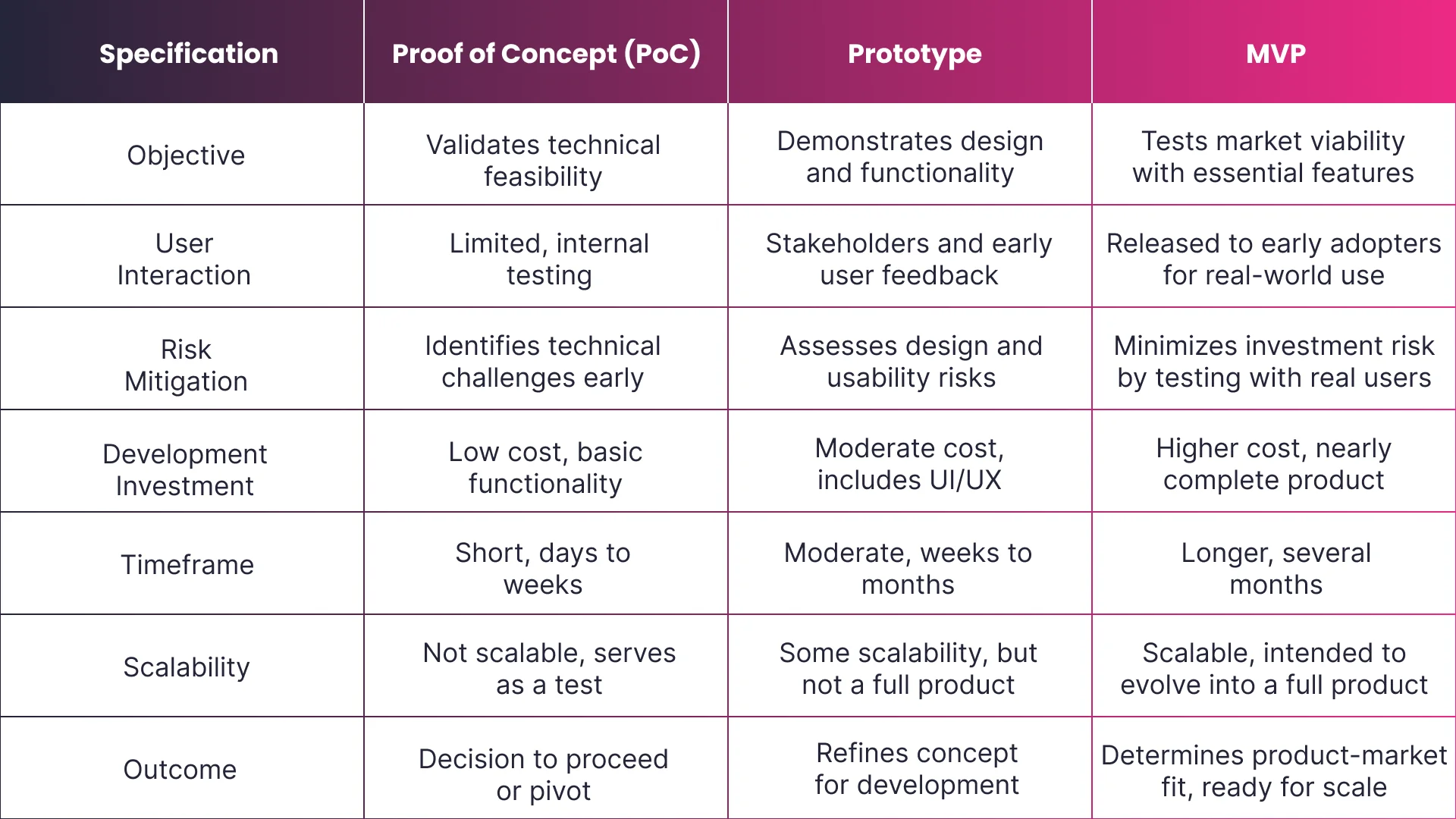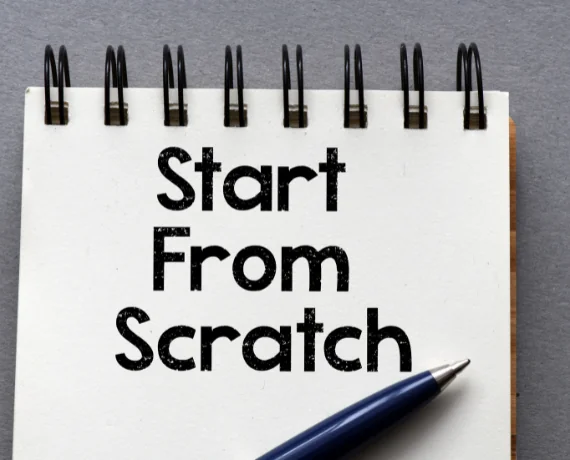Table of Content
- Introduction to Development Stages
- Understanding Proof of Concept (PoC)
- The Role of Prototypes in Software Development
- The Purpose of a Minimum Viable Product (MVP)
- Iterative Development and Feedback Loops
- Comparing PoC, Prototype, and MVP
- Risk Reduction Strategies
- Choosing the Right Approach for Your Startup
- Practical Example: From PoC to Product
- Common Misconceptions
- Conclusion
Let's build your product
Book a callValidating an idea in software development through a proof of concept (PoC), prototype, or minimum viable product (MVP), is crucial to preventing expensive errors. A PoC checks the feasibility of a core idea with limited functionality, while a prototype vs MVP comparison illustrates how the product would function with a basic interface and features. An MVP has enough capabilities to draw in early users and collect feedback for enhancement. Knowing when to use each will help maximize success chances by saving time and money. In this guide, we’ll look at the distinctions among these three ideas: proof of concept vs prototype vs MVP. You will be clear about when to apply each strategy and how it could help your product develop successfully.
Introduction to Development Stages
The product development process involves several stages, each with its own unique characteristics and objectives. Understanding these stages is crucial for transforming ideas into successful products. The three primary development stages are Proof of Concept (PoC), Prototype, and Minimum Viable Product (MVP). Each stage plays a vital role in validating assumptions, gathering user feedback, and refining the product concept.
A Proof of Concept (PoC) is the initial stage where the feasibility of the core idea is tested. It helps in determining whether the concept can be practically implemented. Once the PoC validates the technical viability, the next step is to create a Prototype. This stage focuses on design and usability, providing a tangible model to test user interactions and gather feedback. Finally, the Minimum Viable Product (MVP) is developed, which is a functional product with just enough features to attract early adopters and gather valuable insights for further development.
By navigating these stages effectively, businesses can minimize risks, optimize resources, and increase the chances of creating a product that meets the needs of its target audience. This structured approach ensures that each development stage builds upon the previous one, leading to a well-rounded and market-ready product.
Understanding Proof of Concept (PoC)
A proof of concept (PoC) is a means of determining if a notion or idea is practically realistic. As the first stage of development, it helps to verify that the basic concept can function before mass software development. The goal is to demonstrate technical viability, often through a simplified model or basic functionality, while also potentially assessing the concept’s business or market feasibility. Additionally, it is crucial to evaluate the technical capabilities to validate whether the necessary tools and resources can effectively support the project’s objectives.
Key features of a PoC include its limited scope and focus. It’s not a complete product or even a prototype; instead, it is a test of specific aspects of the concept. This allows for quick validation with minimal resource commitment. The results help decide whether to proceed, pivot, or abandon the idea. Early feedback from stakeholders can lead to necessary improvements, ultimately guiding the project’s direction and enhancing its viability.
A PoC has obviously clear advantages:
- Early identification of difficulties saves time and money, therefore lowering risk.
- It also gives a chance to get first comments from stakeholders, which is essential for refining the idea before moving into more advanced phases like PoC vs MVP vs prototype.
- Secures stakeholder buy-in by demonstrating that a concept is technically feasible, which helps gain the support needed for the upcoming stages.
- Larger companies especially depend on this, as several approvals are needed.
When comparing proof of concept vs prototype vs MVP, a PoC is the initial step in working with a technical product idea. Unlike prototypes and MVPs, which examine user experience and market fit, it just considers how risky the idea is and how confident the client is in it. This makes it a great tool for early-stage validation.
A PoC is, all things considered, a strategic tool for the process of product development. It provides the technological feasibility of a concept, thereby directing future progress. Regardless of its simplicity or basic implementation, a PoC, which provides the earliest indication of the prospective success of a concept, is key in the PoC vs MVP vs prototype comparison.
The Role of Prototypes in Software Development
A prototype is an early form of a product, designed to test certain features and get comments before the MVP development or software development. Whereas a proof of concept stresses practicality, a prototype stresses design and usability. It lets stakeholders provide comments and offers a practical preview of the product. Prototypes are also used to gather initial feedback from test users, helping refine the product early in the development process.
In the discussion between prototype vs MVP, prototypes are crucial as they close the gap between idea validation and market testing. They let teams see and address problems early on, therefore saving later expensive revisions and helping to envision the design and functionality of the product. Prototypes are evaluated by intended users to ensure the product meets their needs and expectations.
A prototype’s main advantage is that it makes iterative testing possible. Client comments let developers improve the design and functionality of the product. In the prototype vs MVP discussions, a prototype is essential for honing concepts before more general publication.
In the prototype vs MVP vs PoC sequence, a prototype offers more detail than a PoC but is not as fully developed as an MVP. It emphasizes design and user experience, ensuring the product is functional and easy to use.
Prototypes also enable the development team to match stakeholders with its activities. Especially in bigger projects, they lower the possibility of misinterpretation by giving everyone a concrete representation, therefore ensuring the direction of the project.
At last, in the prototype vs PoC vs MVP process, the prototype prepares the MVP. It lets one experiment with several designs and features, therefore producing a product that appeals to consumers functionally as well as aesthetically.
Looking for a tech partner for your startup?
The Purpose of a Minimum Viable Product (MVP)
A minimum viable product (MVP) is the simplest form of a product that can be sold to customers. It contains just enough functionality to entice early adopters and solicit input for future development. Real users interacting with the MVP provide valuable insights. The major purpose is to test the product on the market with little money and time.
In the MVP vs prototype comparison, an MVP is more advanced. While a prototype tests design and functionality, an MVP is a fully functional product that users can interact with. It’s not just about validating an idea, but also about understanding market responses, and the technology aspect. On the good side, both will help you to answer quite important question in the development: “How to choose a tech stack“. That will ease the future work.
Since it enables real-world testing, an MVP is absolutely vital. Unlike a prototype, which is generally employed inside, an MVP is made available to real consumers. Crucially, for the latter stage of product improvement, early user feedback helps refine the MVP by providing an insightful analysis of consumer behavior and market demand. The difference between MVP vs prototype and PoC is obvious: the MVP is the first version to hit the market.
An MVP’s contribution to verifying product-market fit is one of the advantages. Release a basic version to help businesses estimate demand and make wise decisions for future growth. In the MVP vs PoC vs prototype process, this stage is crucial, as it marks the last one before whole-scale product development.
Businesses trying to create an MVP should team with seasoned experts. See our MVP software development services for other ideas on how to produce a standout MVP.
Iterative Development and Feedback Loops
Iterative development is a cornerstone of modern software development, allowing teams to refine their products based on continuous feedback from users. This approach involves releasing a product in stages, with each stage building upon the previous one. The feedback loop is essential, as it enables developers to identify areas for improvement, prioritize features, and make necessary adjustments to ensure the final product meets user expectations.
By embracing iterative development and feedback loops, businesses can create products that are more likely to achieve product-market fit and satisfy the needs of early customers. This method allows for constant refinement and enhancement, ensuring that the product evolves in line with user needs and market demands. It also helps in identifying and addressing potential issues early in the development process, saving time and resources in the long run.
Incorporating user feedback at every stage of development ensures that the final product is not only functional but also aligned with what users want and need. This iterative process is crucial for creating a product that stands out in the market and meets the high expectations of its users.
Comparing PoC, Prototype, and MVP
In software development, it’s important to understand the differences between a proof of concept vs prototype vs MVP. The different stages of product development include proof of concept (PoC), prototypes, and minimum viable products (MVP). The table above illustrates the differences between MVP vs prototype and PoC:

What you want to accomplish at that given level will determine whether proof of concept vs prototype vs MVP is more appropriate. The key characteristics of each stage, such as small scale and simplicity for PoC, UI/UX demonstration for prototypes, and core functionalities for MVP, are critical for validating user needs and testing feasibility. Using the strengths of every company can help you reduce risks and guarantee a more straight route to market success.
See our article on MVP for Travel to get more ideas on how to best apply an MVP to your project, especially in the travel sector.
Risk Reduction Strategies
One of the primary objectives of the PoC, Prototype, and MVP stages is to reduce risk. By validating assumptions, testing core features, and gathering user feedback, businesses can identify potential pitfalls and make informed decisions about further development. This risk reduction strategy is critical, as it helps companies avoid investing significant resources into a product that may not meet market demand.
A Proof of Concept (PoC) helps in identifying major technical challenges early on, ensuring that the core idea is feasible before moving forward. The Prototype stage allows for testing design and usability, providing insights into user interactions and potential improvements. Finally, the Minimum Viable Product (MVP) stage involves releasing a functional product to a limited audience, gathering real-world feedback, and making necessary adjustments based on user responses.
By adopting a phased approach to product development, businesses can minimize the risk of failure and ensure that their products are financially viable. This structured method allows for careful evaluation at each stage, reducing the likelihood of costly mistakes and increasing the chances of creating a successful product.
Choosing the Right Approach for Your Startup
Maximizing resources and raising the possibility of success depends on knowing when to employ a proof of concept (PoC), prototype, or minimum viable product (MVP). Effective project management is crucial in the development process to ensure each step is properly executed. Each step in the MVP vs prototype and PoC process has a specific purpose and helps refine the idea before it reaches the market:
- Proof of Concept (PoC): Aiming at verifying if the proposal is technically possible, a PoC comes first. Usually used to evaluate the basic performance in a controlled setting, it guarantees that the idea can be implemented in reality. This stage is crucial for identifying any major technical hurdles early on. When comparing proof of concept vs prototype vs MVP, the PoC is the foundation that helps validate the technical viability before moving forward.
- Prototype: Making a prototype comes next once the PoC guarantees viability. Focusing on design and user experience, a prototype offers a physical model showing the appearance and operation of the finished product. It’s utilized for user interaction tests and stakeholder comment collection. This step is particularly important in the MVP vs prototype vs PoC sequence, as it helps refine the concept before full development.
- Minimum Viable Product (MVP): Following test and improvement of the prototype, develops an MVP. This is a functional form of the product with just enough characteristics to appeal to early consumers and support the demand on the market. An MVP plays a critical role in validating the business model by allowing startups to gather real user feedback and make necessary adjustments. Startups may immediately join the market, test the product with actual consumers, and get insightful comments from the MVP for future versions. The MVP in the prototype vs proof of concept vs MVP process is the stage whereby the product is first shown to real consumers.
Choosing the right approach, whether prototype vs MVP or PoC, depends on your specific goals and where you are in the development process.
Prototype, MVP, or PoC? We can help you to decide which approach is better for you based on your project's goals, budget, and timeline.

Practical Example: From PoC to Product
Imagine a startup developing a mobile app for booking last-minute hotel deals. The team begins with a Proof of Concept (PoC) to validate whether their algorithm can scan hotel databases in real-time to find available rooms at discounted rates. This PoC focused on building a simple backend tool that could search and return results from a small set of hotel data. The goal was to prove that the technology could work, not to create a user-friendly product, reflecting the PoC vs prototype vs MVP vs pilot stages of development.
The team starts building a prototype once the PoC proves the central concept can be achieved. The prototype includes a simple user interface so that interested parties could see how the app might appear and operate. This version has few tools; users can only find hotels; booking is not yet possible. User experience, design testing, and getting comments to hone the idea took center stage. The difference between a prototype vs MVP is evident in this case because the prototype is only a working tool that shows off the potential features of the program. Positive feedback from early users is crucial in refining the MVP.
After refining the design based on feedback, the team develops the Minimum Viable Product (MVP). This iteration of the software adds money processing, booking options, and real-time hotel searches. It is released to a limited audience to test the market’s response. The PoC vs prototype vs MVP process comes full circle, with the MVP representing the first real product users can engage with.
In this prototype vs. MVP and PoC path, the MVP proves the software can draw people and make money. Still a basic product, though, the team must decide whether to grow the software into a full-fledged product or stop with the MVP. Stopping at the MVP stage is an option, but it would limit the app’s potential. Validating the market need before full-scale development is essential to ensure the product resonates with actual user demands. Scaling meant adding more features, such as user reviews, advanced filtering options, and integration with other travel services, reflecting the considerations in the PoC vs prototype vs MVP vs pilot stages.
The team would have missed out on grabbing a bigger market share but saved resources if they had stopped at the MVP level. The choice to keep developing produced a stronger product appealing to a larger market. This highlights the critical role of understanding PoC vs prototype vs MVP and the long-term implications of stopping at each stage.
For those interested in how to approach the MVP stage effectively, check out our article on how to build an MVP. It provides valuable insights into taking your product from a simple concept to a market-ready solution.
Discover about how to build an MVP and how long it takes
Common Misconceptions
There are several common misconceptions surrounding the PoC, Prototype, and MVP stages. One of the most significant misconceptions is that these stages are interchangeable or that one can be skipped altogether. However, each stage has its own unique purpose and is essential for ensuring the success of the product.
Another misconception is that the MVP stage is about releasing a bare-bones product with minimal features. In reality, the MVP should have just enough features to satisfy early customers and provide valuable insights for future development. It is not merely a stripped-down version of the final product but a strategic tool to test the market and gather feedback.
By understanding these misconceptions and adopting a nuanced approach to product development, businesses can create products that meet the needs of their target audience and achieve long-term success. Each stage, from PoC to Prototype to MVP, plays a crucial role in refining the product concept and ensuring that the final product is well-received in the market.
Conclusion
Understanding the functions of a proof of concept, prototype, and minimum viable product is absolutely vital during development. Transitioning from these initial stages to full-scale development is a critical step. From providing technical feasibility to honing design and evaluating commercial viability, each stage, proof of concept vs prototype vs MVP, serves a distinct goal. The success of the last product may be greatly influenced by wise judgments made at every level.
It’s crucial to understand how each step builds on the next as you go from PoC vs prototype vs MVP to the final product. Emphasizing core functionalities at each stage ensures that essential features are tested and validated. Using a prototype vs MVP vs product method guarantees that your development process is exhaustive and sensitive to user requirements. Following these phases will help you reduce risks and maximize the possibility of producing a profitable and marketable product.
No, an MVP (Minimum Viable Product) is not a Prototype. While they share some similarities, they have different purposes in product development. An MVP introduces a product to the market with the minimum features necessary to satisfy early adopters and attract investors. The purpose of a Prototype is to test and validate a product’s core concept, design, and functionality before full development.
Budget allocation varies by project, but generally increases from PoC to prototype to MVP. A PoC is the least expensive, focusing on core functionality, while a prototype requires more investment in design, and an MVP demands the highest budget for a market-ready product.
A PoC tests if an idea is technically possible, a prototype uncovers design and usability, and an MVP is a functional product released to users.
Choose a PoC when the main concern is technical feasibility. If the idea’s viability is uncertain, a PoC helps avoid unnecessary investment. In contrast, a prototype is better for testing design and user interaction.
While not always required, creating a PoC is advisable if there are doubts about technical feasibility. It helps to validate the idea before investing in a prototype or MVP.
Yes, a proof of concept (PoC) could develop into a prototype or MVP. Following PoC validation of the fundamental concept, it may be developed as an MVP for market testing or a prototype to test design and capability.
Questions? Answers!
Is MVP a Prototype?
No, an MVP (Minimum Viable Product) is not a Prototype. While they share some similarities, they have different purposes in product development. An MVP introduces a product to the market with the minimum features necessary to satisfy early adopters and attract investors. The purpose of a Prototype is to test and validate a product’s core concept, design, and functionality before full development.
How much of the budget is typically allocated for a proof of concept, prototype, and MVP?
Budget allocation varies by project, but generally increases from PoC to prototype to MVP. A PoC is the least expensive, focusing on core functionality, while a prototype requires more investment in design, and an MVP demands the highest budget for a market-ready product.
What is the main difference between a proof of concept, prototype, and MVP?
A PoC tests if an idea is technically possible, a prototype uncovers design and usability, and an MVP is a functional product released to users.
When should I choose a proof of concept over a prototype?
Choose a PoC when the main concern is technical feasibility. If the idea’s viability is uncertain, a PoC helps avoid unnecessary investment. In contrast, a prototype is better for testing design and user interaction.
Is creating a proof of concept necessary before building a prototype or MVP?
While not always required, creating a PoC is advisable if there are doubts about technical feasibility. It helps to validate the idea before investing in a prototype or MVP.
Can a proof of concept become a prototype or MVP?
Yes, a proof of concept (PoC) could develop into a prototype or MVP. Following PoC validation of the fundamental concept, it may be developed as an MVP for market testing or a prototype to test design and capability.




